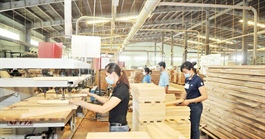Pressure on to develop feed materials
Pressure on to develop feed materials
Struggling with the sharp increase in the price of animal feed materials, the husbandry industry has a headache figuring out solutions for long-term, sustainable development.
Since 2020, the animal feed price in the country has already been adjusted nine times, significantly affecting the production of farmers, especially while the selling prices of poultry and live hogs are falling.
In the context of accelerating the recovery of production and livestock, relying too much on imported raw materials will keep the price of animal feed high. In the government’s Resolution No.128/NQ-CP on interim regulations on safe and flexible adaption to the pandemic released last month, the government highlighted that the agricultural industry should seek local material resources for the production of animal feed and mitigate the dependence on imports.
Instead of using industrial feed, Doai Phuong Cooperative in Hanoi’s Son Tay town has fed 80,000 chickens with feed cooked in the cooperative. This not only reduces livestock costs but also improves quality. “Proactively controlling the supply of animal feed, we are managing the process more easily and accounting for the costs for every stage,” said Nguyen Huy Ba, director of Doai Phuong Cooperative.
Using available raw materials from domestic crop and livestock, this cooperative has been producing self-mixed animal feed and save costs for animal feed by 20 per cent.
Strengthening production in biosecurity to reduce production costs has been promoted by some localities in recent times. However, this may be the best solution for short-term and small- and medium-sized farms only.
“Certainly, we believe there are certain raw materials that are suitable for Vietnam’s climate. One example is corn, a key raw material in animal feed that local supply cannot meet the demand yet,” Johan van den Ban, general director of De Heus Vietnam and Cambodia, told VIR. “Vietnam can consider moving low-productivity rice areas to grow corn, which will be very beneficial for feed producers to reduce dependency on imports.”
No sign of decline
However, corn productivity in Vietnam in general is lower than worldwide (at about 80 per cent). “It is not necessarily something negative for Vietnam to be dependent on imports for certain raw materials that are produced more efficiently in other parts of the world, as long as Vietnam can utilise its resources optimally,” said van den Ban.
He added this is already happening with agri-food products such as basa fillet, shrimp, and other seafood, as well as other important products like coffee, fruit, and vegetables.
Pham Thi Huan, CEO of Ba Huan JSC, said that for Vietnam’s livestock industry to overcome difficulties and develop sustainably, the industry must pay attention to self-growing corn, reducing or even removing dependence on imports. “Vietnam is a top rice producer, so it can afford to use cheaper rice when used as a raw material for animal feed production,” she said.
Meanwhile, the cost of fuel and raw materials still shows no sign of decline. Animal feed producers around the world are importing minerals and vitamins from China, but these ingredients’ factories have had operations halted in many areas due to sharp energy cost increases.
Van den Ban explained, “Therefore, we do expect the price of these key materials to eventually come down. But right now, this is a challenge for feed companies and farmers in controlling production prices while adapting to the slow recovery of animal protein demand.”
Despite being one of the leading countries in producing and exporting agricultural food, Vietnam depends heavily on imported materials for animal feed at about 20 million tonnes imported every year, mainly made up of soybeans, corn, and wheat.
Vice chairman of the Vietnam Animal Feed Association, Nguyen Xuan Duong, said that Vietnam needs an additional 8 million tonnes of biomass corn to make feed materials for buffaloes and cows. “This is a space for localities to take advantage of and develop biomass maize, reducing the volume of imported materials,” said Duong.
Driving up prices
On average, the country has nearly 157 million tonnes of agricultural by-products each year. In the coming time, it is necessary to have more policies to encourage enterprises to invest in technology to turn by-products into a source of feed for livestock.
“We should facilitate all organisations and individuals to apply science and technology to make good use of agricultural by-products,” said Tong Xuan Chinh, deputy director-general of the Department of Livestock Production under the Ministry of Agriculture and Rural Development.
In addition, experts also held that more supportive policies are needed to form large raw material production areas and value chains in the animal feed industry.
Along with the growth of the livestock industry, the animal feed industry is growing at an average of 13-15 per cent per year, so the pressure to develop input materials is relatively large. According to the General Department of Vietnam Customs, as of October 15, Vietnam imported 13.54 million tonnes of wheat, corn, and soybeans, worth $4.328 billion, up 2.42 per cent in volume. Every year, the agricultural sector can only provide a maximum of 13 million tonnes of corn, rice bran, and cassava for animal feed production, while the annual demand stands at up to 27 million tonnes.
“Companies processing industrial animal feed are not interested in collecting materials that are too small. The price of local raw materials is up to 20 per cent higher than imported ones. Thousands of tonnes of materials are imported at the same time and of the same quality,” said Duong.

























